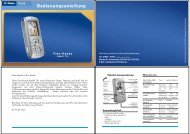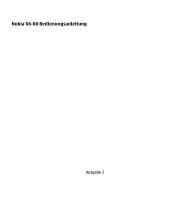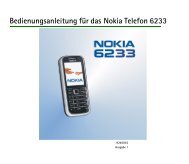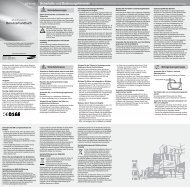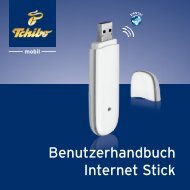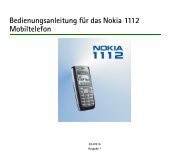Nokia 100 User Guide
Nokia 100 User Guide
Nokia 100 User Guide
You also want an ePaper? Increase the reach of your titles
YUMPU automatically turns print PDFs into web optimized ePapers that Google loves.
attery or charger. Only use the charger<br />
indoors.<br />
Additional safety information<br />
Emergency calls<br />
Make an emergency call<br />
1. Ensure the device is switched on.<br />
2. Check for adequate signal strength. You<br />
may also need to do the following:<br />
• Insert a SIM card.<br />
• Remove call restrictions you have<br />
activated for your device, such as call barring,<br />
fixed dialling, or closed user group.<br />
• Ensure your device is not in an offline or<br />
flight profile.<br />
3. To clear the display, press the end key as<br />
many times as needed.<br />
4. Enter the official emergency number for<br />
your present location. Emergency call<br />
numbers vary by location.<br />
5. Press the call key.<br />
6. Give the necessary information as<br />
accurately as possible. Do not end the call until<br />
given permission to do so.<br />
Important: Activate both cellular and<br />
internet calls, if your device supports internet<br />
calls. The device may attempt to make<br />
emergency calls both through cellular<br />
networks and through your internet call<br />
service provider. Connections in all conditions<br />
cannot be guaranteed. Never rely solely on any<br />
wireless device for essential communications<br />
like medical emergencies.<br />
Small children<br />
Your device and its accessories are not toys.<br />
They may contain small parts. Keep them out<br />
of the reach of small children.<br />
Medical devices<br />
Operation of radio transmitting equipment,<br />
including wireless phones, may interfere with<br />
the function of inadequately protected<br />
medical devices. Consult a physician or the<br />
manufacturer of the medical device to<br />
determine whether they are adequately<br />
shielded from external radio frequency<br />
energy.<br />
Implanted medical devices<br />
Manufacturers of medical devices recommend<br />
a minimum separation of 15.3 centimetres (6<br />
inches) between a wireless device and an<br />
implanted medical device, such as a<br />
pacemaker or implanted cardioverter<br />
defibrillator, to avoid potential interference<br />
with the medical device. Persons who have<br />
such devices should:<br />
• Always keep the wireless device more<br />
than 15.3 centimetres (6 inches) from the<br />
medical device.<br />
• Not carry the wireless device in a breast<br />
pocket.<br />
• Hold the wireless device to the ear<br />
opposite the medical device.<br />
• Turn the wireless device off if there is any<br />
reason to suspect that interference is taking<br />
place.<br />
• Follow the manufacturer directions for<br />
the implanted medical device.




